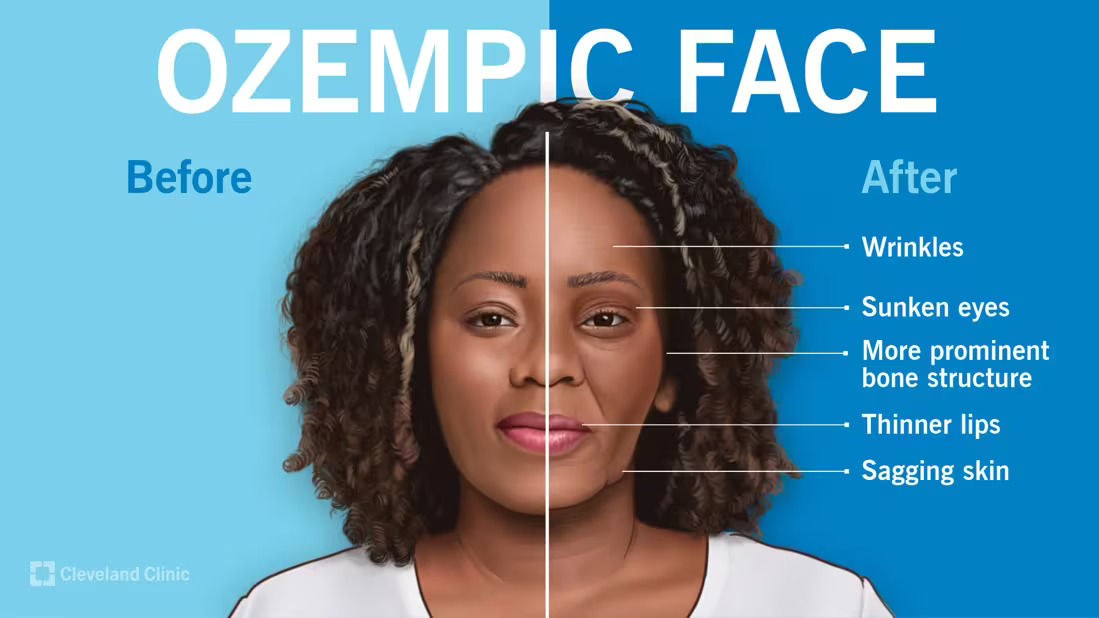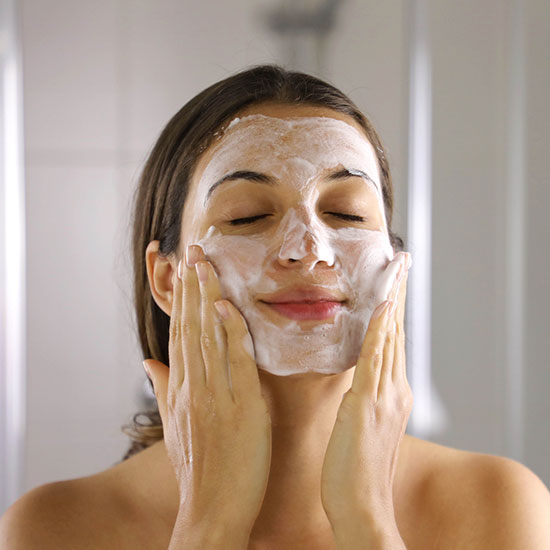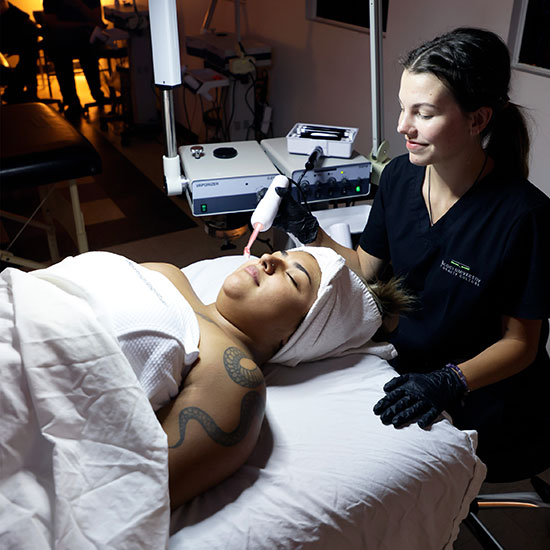Ozempic, Wegovy, and Mounjaro have become household names, sparking waves of conversations not just about weight loss, but also about beauty. As more people turn to these medications, many are celebrating transformative results on the scale. But some users are also noticing new, less welcome changes in the mirror: looser skin, hollow cheeks, or a face that suddenly looks older than it feels.
Dermatologists have dubbed this phenomenon “Ozempic Face.” It’s not a medical diagnosis, but a nickname for the visible effects of rapid weight loss – especially the loss of facial fat that can leave skin looking less firm or radiant.
While a lot of online chatter is focused on injectables and cosmetic procedures, there’s another, often-overlooked resource for restoring confidence: the right esthetician.
Licensed estheticians understand skin health from the inside out. They know how to hydrate, tone, and nourish skin that’s adjusting to rapid change. Through personalized, non-invasive care – and a healthy dose of empathy and client care – they help clients feel comfortable in their skin again.
What’s Actually Happening When ‘Ozempic Face’ Appears

When the body loses fat, it loses it everywhere, including the face. Rapid fat loss in the face can lead to:
- Loss of volume in cheeks and temples
- Looser skin along the jawline
- More prominent wrinkles or folds
- A generally “tired” or aged appearance
The unwanted effects aren’t caused by the medication itself but by the speed and amount of fat loss. Add in the natural collagen decline that comes with age, and skin may struggle to “bounce back.”
The Cleveland Clinic explains that while some people may turn to fillers to replace lost volume, others prefer gradual, non-invasive options that focus on skin health – and that’s where estheticians excel.
Why “Ozempic Face” Matters to Estheticians
Estheticians are often the first beauty professionals clients turn to when something about their skin feels “off.” They may not know exactly what’s causing the changes they see in the mirror, but they do know they want help.
That’s where estheticians come in. As skilled professionals, they’re uniquely positioned to educate clients about what’s happening beneath the skin’s surface, recommend treatments that restore tone and hydration, and offer practical ways to bring back balance and radiance through skincare and makeup.
People are often caught off guard by the facial changes that can come with rapid weight loss – and it’s not just physical. After months of hard work and transformation, seeing a reflection that looks tired or older than expected can feel discouraging.
That’s where an esthetician can make a big difference. A great facial is about getting your glow back, but it’s also about reassurance. Clients often leave not just refreshed on the outside, but reminded that their skin is resilient, adaptable, and absolutely capable of looking healthy and radiant again.
How Estheticians Help Clients with ‘Ozempic Face’

1. Replenishing Hydration and Restoring Skin Health
A strong skin barrier does more than just look healthy. It actually helps skin retain moisture and resist future sagging. Research from the National Institutes of Health shows that maintaining hydration directly improves elasticity and surface smoothness.
When rapid weight loss leaves skin looking dehydrated and dull, estheticians use professional-grade products and techniques to strengthen the skin barrier, restore moisture, and revive natural elasticity.
Treatments often focus on:
- Deep hydration using hyaluronic acid or ceramide-rich products
- Gentle exfoliation to promote smoother texture
- Facial massage and lymphatic drainage to improve circulation and radiance
2. Encouraging Collagen and Firmness Naturally
Collagen loss is a normal part of aging, but when weight comes off quickly, those changes can show up a little faster than expected. Skin may feel thinner or less firm, and clients often describe their face as looking “tired” even when they feel great inside.
Estheticians can help bridge that gap with treatments that gently encourage the skin’s natural repair process. Non-invasive options like LED light therapy, microcurrent facials, or radiofrequency treatments can boost circulation and support collagen production over time. Even a series of facials that incorporate peptides, vitamin C, or gentle retinol alternatives can gradually improve firmness and elasticity without irritation.
Unlike injectables, these approaches work with the skin, not against it. Results build gradually for a refreshed, healthy look that still feels authentic to the client’s natural features.
The education piece matters just as much. Estheticians can help guide clients toward everyday habits that make a real difference, like staying hydrated, maintaining a balanced diet, getting enough sleep, and following a consistent skincare routine. Collagen maintenance isn’t about quick fixes; it’s about consistency. Small, steady efforts add up to visible, lasting results.
3. Using Makeup to Restore Softness and Dimension
Estheticians and makeup artists understand how light, texture, and color work together to bring balance back to the face. When facial features shift after rapid weight loss, makeup can help restore a feeling of confidence.
The goal isn’t to cover up change, but to bring warmth, softness, and life back to the skin. Dewy foundations and cream-based products add luminosity, while a touch of blush high on the cheeks, or a subtle highlight at the temples can mimic the fullness that’s been lost. These techniques create a healthy, natural finish that catches the light and draws attention to eyes, lips, and smile.
Because estheticians see each face as unique, they’re able to tailor application techniques to complement individual bone structure and tone rather than forcing trends that don’t fit. They know that a radiant finish reads younger and more rested than a heavily contoured one, and that well-prepped, hydrated skin will always make makeup look better.
4. Supporting Circulation and Tone Through Touch
A skilled esthetician’s hands can bring immediate vitality to skin that feels depleted. Facial massage, Gua Sha, and other hands-on techniques are staples in the esthetician’s toolkit. They boost circulation, encourage lymphatic drainage, and bring visible vitality to tired skin. They also offer a moment of calm and connection – helping clients relax and reconnect with themselves.
Facial massage can also lower stress, improve circulation, and promote an overall sense of well-being – all of which contribute to healthier-looking skin. Clients often describe feeling lighter, calmer, and more grounded after a session, as though they’ve released tension they didn’t realize they were holding.
The power of touch reminds clients that their skin isn’t something to fight against, but something that deserves nurturing.
5. Providing Guidance (and Guardrails)
Working with a licensed esthetician means knowing you’re in safe, knowledgeable hands. Estheticians don’t diagnose or perform injections, but they know when to refer clients to dermatologists or medical providers if something’s outside their scope. That balance of care and caution builds lasting trust – and clients who return again and again.
Every recommendation they make comes from training, experience, and an understanding of how different skin types respond to change. They know when to adjust a treatment plan, when to take things slow, and how to create results that look natural and feel sustainable. Estheticians meet people where they are, offering expert care, real results, and the reassurance that their skin can look and feel vibrant again.
Why Working with an Esthetician Makes a Difference

In an era of quick fixes and viral trends, estheticians offer something that’s become increasingly rare these days: personalized, evidence-based care.
Here’s what sets them apart:
- Education: Licensed estheticians train extensively in anatomy, skin physiology, and product chemistry.
- Customization: Every treatment plan is tailored to the client’s skin type, age, and goals.
- Accessibility: Esthetics services are often more affordable and less invasive than medical alternatives.
- Confidence building: Beyond products and procedures, estheticians listen, educate, and empower clients to love their skin again.
At the heart of it all, estheticians blend science with empathy. They’re educators, caretakers, problem-solvers – even artists. And for clients navigating visible changes like “Ozempic Face,” that combination of knowledge, trust, and human connection can make a big difference.
Embracing Change with Care
Working with an esthetician gives clients the space to care for their skin with patience instead of panic. Together, they can focus on nourishing what’s already there, restoring hydration, supporting elasticity, and bringing back a healthy, natural glow. Gentle treatments and thoughtful guidance go a long way in helping skin adjust, but the real transformation often happens in mindset. Clients begin to see change not as something to hide, but as a sign of growth, resilience, and care.
And that perspective – that beauty can evolve right alongside us – is something every future esthetician learns to nurture.
The Bigger Picture for Future Estheticians
For future estheticians, trends like “Ozempic Face” are more than passing headlines – they’re proof of how important this work really is. The beauty industry evolves fast, and new challenges pop up every year. But one thing stays the same: people will always need professionals who can help them feel at home in their own skin.
Whether it’s guiding someone through a big life change or simply helping them rediscover their glow, estheticians do more than care for skin: they also care for people.
At Tricoci University of Beauty Culture, esthetics students learn how to blend science with artistry and empathy. They study the “why” behind skin behavior and the “how” of restoring balance, so that when new beauty trends or concerns emerge, they’re ready to respond with skill, confidence, and compassion.
Being an esthetician means having the knowledge to adapt, the creativity to personalize every service, and the heart to make each client feel seen and supported.
Ready to start your journey? Learn more about Tricoci University’s Esthetics Program and discover how to turn your passion for skincare into a rewarding career helping others feel confident in theirs.





